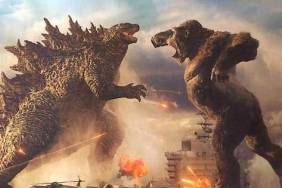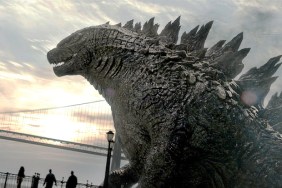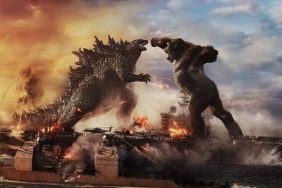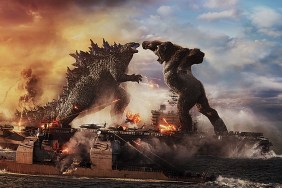It ain’t nothin’ but a G thang, baby.
I have returned from my quest, broken, bleeding, and spiritually crushed. Last week in my epic Summer of Godzilla, here in The Series Project, I took an intermission from the Godzilla movie proper to write about a few animated shorts, and to cover the phenomenon of Godzilla on TV. My reason for doing this was twofold: For one, there was a lot of ancillary Godzilla material to cover, and I didn’t want to tack it on at the very end after I had seen all the movies, and for another thing, I, uh, wasn’t able to track down a copy of 1984’s The Return of Godzilla, which was the Japanese version of the first film in the Heisei era of Godzilla films. I was easily able to track down a copy of Godzilla 1985, the American version of the same movie, but the Japanese version proved difficult, even after looking to Japanese shopping outlets, illegal virus-inducing download sites, and that one shady underground video-theater-slash-Russian-roulette casino.
Well, after losing some money to a credit card thief, and being forcibly tattooed (I now have the Russian phrase “Язык кино является универсальным.” scrawled on the back of my thigh), I have returned with the regretful news that I have not been able to see The Return of Godzilla. I know. I know. I am remiss. This is, I of course, a grievous oversight on my part, and I fully intend to continue my hunt for the film (my new tattoo will likely open up new avenues of criminal possibilities I was previously not privy to), but for the time being, I think I need to move on. I don’t want to delay you, dear readers, any longer, and I am eager to get back to the monster mayhem that I am enjoying so much. So I will pick up this week’s installment of The Series Project where I left off two weeks ago (with the amazing Godzilla vs. Mechagodzilla), and charge ahead with the next four Godzilla movies. That means I will be wrapping up the Toho/Showa era of film with Terror of Mechagodzilla, entering the Heisei era with Godzilla 1985, and writing about the first two films to follow the reboot, Godzilla vs. Biollante, and Godzilla vs. King Ghidorah. The flavor of films changes a lot for the Heisei era, which I will be discussing at some length below.
For now, though, I will pick up with a movie that is just as crazy and pretty much as good as Godzilla vs. Mechagodzilla…
Terror of Mechagodzilla


Release Date: 15th March 1975
Monster: Titanosaurus
Description: Long-necked underwater bipedal dinosaur
Origin: Just sort of hanging out underwater for millions of years.
Destruction: Brain-beamed by humans, then pummeled by Godzilla.
Actor(s): Katsumi Nimiamoto (Titanosaurus), Toru Kawai (Godzilla), Ise Mori (Mechagodzilla)
Ancillary Monster: Mechagodzilla
This was the final film of an era. This would be the last Godzilla film to be made by Ishiro Honda, the director of the 1954 original, and the man behind most of the sequels to date. Indeed, this would be the last film Honda would direct until 1990’s Dreams, an anthology film conceived of by Akira Kurosawa. Honda died in 1993. The world of sci-fi lost a considerable talent, and one of the modern masters of monsters. Along with people like Forrest J Ackerman, Ray Harryhausen, and Stan Winston, Ishiro Honda is a name that should constantly be on the lips of monster fans. What he did to the world of movies – essentially inventing the kaiju genre – is a vital and stirring accomplishment.
Terror of Mechagodzilla was also the last film in the Showa era, and was actually one of the least successful in the franchise, forcing Toho to put a hiatus on their famous monster. I suppose by the mid-1970s, audiences were tiring of the goofy monster action that marked so many of the films of the ’60s. The appearance of Mechagodzilla has been, as I have iterated before, a wonderful thing, and I love the giant bionic clone of the G-man, but I think most audiences at the time felt that Mechagodzilla was a dumb innovation for the series, and a sign that things were withering in earnest. From 1975 all the way until 1984 (the 30th anniversary of the original) there would be no new Godzilla movies.
In retrospect, this is a pity, because I rather love Terror of Mechagodzilla, and all the goofiness therein. It has all the clunky sci-fi tropes I have come to expect from the series: Several giant monsters wailing on each other, incomprehensible plotting, evil aliens with mind-control rays, and a wonderfully childish tone and story structuring that makes my inner little boy wiggle in delight. It’s not quite as good as Godzilla vs. Mechagodzilla, but it’s still pretty spectacular.

The new monster in this film is Titanosaurus, who, as far as I can tell, has no extraordinary origin whatsoever. Titanosaurus is just a giant upright bipedal dinosaur that has somehow remained alive for millions of years in the depths of the ocean. I have debated in previous Godzilla essays as to whether or not Godzilla is dinosaurs, and whether or no dinosaurs should count as “monsters.” I say they cannot. Titanosaurus is a dinosaur, but it’s a one-of-a-kind monster-ish dinosaur, so I guess it counts as a monster. Later in the series, the dinosaur connection will become even stronger. Titanosaurus, like so many monsters in the past, is discovered by a race of evil aliens with mind-control devices, hellbent on destroying Earth with its native monsters. Also their own Mechagodzilla. It’s pretty straightforward for a Godzilla movie. Mechagodzilla, by the way, was salvaged from the ocean floor after the last movie and rebuilt. I don’t think, however, that these are the same ape-headed aliens from the previous film. I think there are wicked skinless ghouls like in Beneath the Planet of the Apes. The aliens are led by Goro Mutsumi.
There’s also a subplot about the aliens making a robot clone (played by Tomoko Ai) which they send out into the world to, I dunno, collect information or something. The clone ends up falling in love with an Earth man, and there’s some intrigue with Interpol and with rogue biologists who are kidnapped and forced into helping the evil aliens complete their scheme. This film adheres pretty closely to the Godzilla Rule of Thirds: The first third is all exposition and setup, the second third sees the appearance of Godzilla and the revelation of some evil (often alien) plot to take over the world, and the third third begins with the aliens revealing they are evil and attacking the world with monsters which are, over the course of the final 30 minutes, inevitably fought off by The G. All of the films have been about 90 minutes, and most have the formula in place. Godzilla is, in many ways, more reliable than James Bond.
The humans, of course, catch wise to what’s going on, thanks to some turncoats turning back, and the loving robot clone betraying her people. In a truly tragic twist, the mind-control rays that the aliens are using to control Titanosaurus can only be shut off my destroying a chip inside the robot clone’s brain, forcing her Earthbound boyfriend to murder her. Oh yes, and Mechagodzilla is back, and emerges to fight Godzilla. Godzilla has been hanging out on Monster Island as usual, I believe, and will not stand for bionic Godzillas running around on his turf. Godzilla beats up Mechagodzilla a second time, while humans use a specialized brain ray to break the mind-control link between Titanosaurus and the aliens. You do realize how fun these movies are, right?

An interesting ethical dilemma: Titanosaurus was merely following orders, under the influence of an alien brain ray, unable to do anything but attack human cities. When the brain ray is turned off, Titanosaurus is presumably free to make decisions again. Godzilla, however, shows Titanosaurus no mercy, and pummels and beats him anyway, even after he is free of alien influence. Was Godzilla correct in punishing Titanosaurus for committing crimes he has no choice but to commit? Perhaps. Godzilla is not a just being, but an instrument of defense and of vengeance. Titanosaurus receives no mercy. Godzilla will kick ass. He will. It is his raison d’etre, and he will not be dissuaded.
Terror of Mechagodzilla, as I said, tanked horribly, and I’m guessing the “serious” cinema of the 1970s would no longer tolerate goofy monster films like Godzilla anymore. The makers decided to take a holiday that would last for nine years, the longest gap between films in Godzilla history. Luckily, the monster had to have a 30th anniversary eventually.






